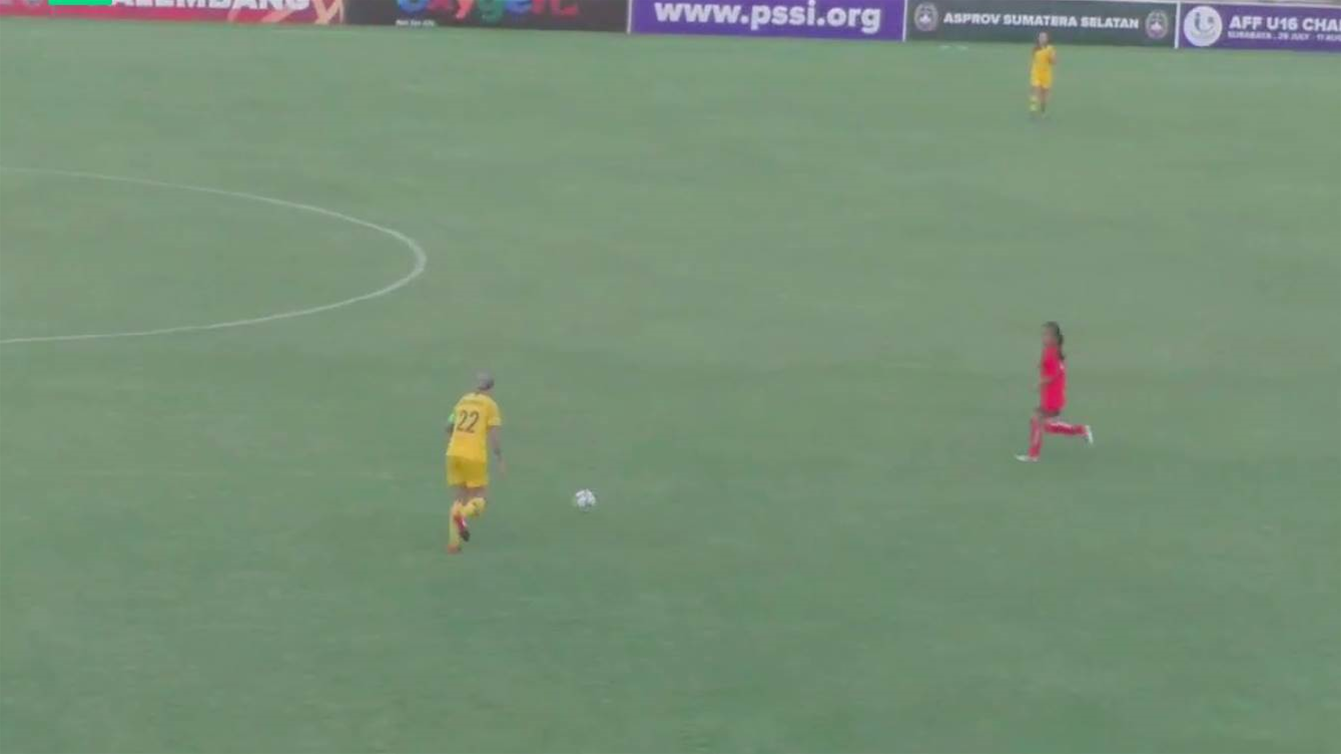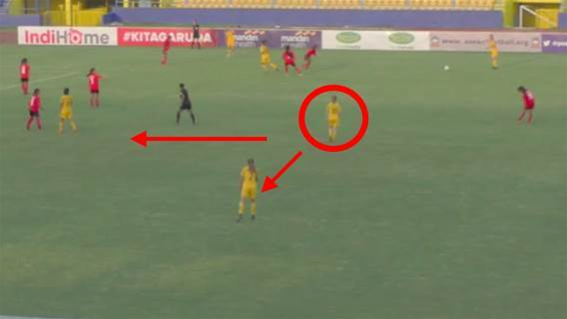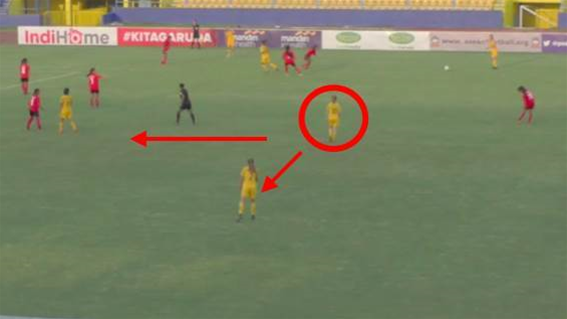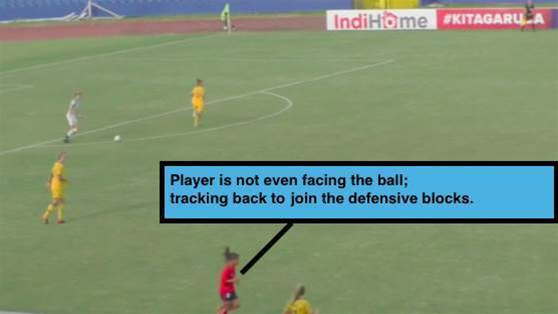The Young Matildas have effectively sealed their place in the semi-finals of the AAF Women’s Championship following a 12-0 drubbing over Cambodia.
Mary Fowler’s five goals in the first half put Australia in a commanding 8-0 lead at the interval and overshadowed MelindaJ Barbieri’s hat-trick.
Bethany Gordon, Holly McNamara, Princess Ibini and Alex Chidiac also got on the scoresheet.
Cambodia’s women did well to hold out in the opening stages; however, the levee broke once Fowler dispatched her opener from just inside the 18-yard box.
Australia did not take long to double — and triple — their lead with Fowler and Gordon’s strikes coming from outside the box.
McNamara added to Australia’s tally, meeting a cross near the byline and side-footing the ball — on the full — inside the near post.
By the end of the half, Australia had an eight-goal lead and were firmly in control. Ibini and Tori Tumeth were introduced for the start of the second half, though the game had lost its intensity.
Ibini dropped deep for her goal, turning into space and hammering home from 25 metres out.
Almost 20 minutes later, Barbieri completed her hat-trick, while Chidiac continued her rich vein of form in injury time after latching onto the keeper’s spill.
The win means Australia will almost certainly qualify for the semi-finals.
ANALYSIS
AUSTRALIA — Possession
Australia effectively played a 2-5-3 formation which would become a 2-3-5 when Kaitlyn Torpey and Emily Hodgson pushed high and wide in the final third. Coach Leah Blayney would have predicted Cambodia’s deep-lying back-five, in which case three forwards would not be enough to break through. This defensive approach from Cambodia allowed the Young Matildas to build up from the back, though they were afforded the luxury of playing straight to Gordon, who effectively had five forward options from which to choose.
While Torpey and Hodgson started higher than conventional wing-backs, success was dependent on the timing of their runs. There were moments where they engaged Cambodia’s wing-backs — Sreyoul and Nimol. This turn denied them space to receive the ball in front of Cambodia’s defence, or make late runs in behind. However, when Torpey and Hodgson dropped back, they put Cambodia’s wing-backs in a conundrum: if they push up, they would leave space in behind or should they back off and allow the Aussie duo possession and space.
Furthermore, Australia only required two centre-backs in possession, as Cambodia’s most forward player was only 30 metres from her own goal. This allowed Larissa Crummer to step up into Cambodia’s half, which had a two-fold effect: 1) She played as an auxiliary No.6, able to offer a back-passing option to recycle possession; 2) Should Australia lose possession, she would deny Cambodia’s No.9 the space to receive the ball and or turn.
 It is important to consider the importance of Bethany Gordon in Blayney’s side. The youngster, who plays for Canberra United, possesses the technical ability to play quick, forward passes, and the tactical nous to control the game. She was the fulcrum on Friday night, as she received the ball facing forward from her defenders, and played a variety of passes — short, long, sideways, forwards, over the top, drilled diagonally to her wingers — to continually split Cambodia’s defence.
It is important to consider the importance of Bethany Gordon in Blayney’s side. The youngster, who plays for Canberra United, possesses the technical ability to play quick, forward passes, and the tactical nous to control the game. She was the fulcrum on Friday night, as she received the ball facing forward from her defenders, and played a variety of passes — short, long, sideways, forwards, over the top, drilled diagonally to her wingers — to continually split Cambodia’s defence.
 Special mention must also go to Fowler. While bagging five goals is an impressive feat, she should be praised for her movement off the ball — coming wide to drag the centre-backs out of position, as well as turning to make a run in behind — as well as her technical ability on it. She was able to accelerate past lethargic defenders, and compose herself to slot some well-taken goals. At times, Fowler engaged two of Cambodia’s centre-backs, which created space for Rachel Lowe and Susan Phonsongkham to play forward passes.
Special mention must also go to Fowler. While bagging five goals is an impressive feat, she should be praised for her movement off the ball — coming wide to drag the centre-backs out of position, as well as turning to make a run in behind — as well as her technical ability on it. She was able to accelerate past lethargic defenders, and compose herself to slot some well-taken goals. At times, Fowler engaged two of Cambodia’s centre-backs, which created space for Rachel Lowe and Susan Phonsongkham to play forward passes.
CAMBODIA — Possession
Producing a proper analysis of Cambodia’s ability in possession, particularly based off this match, was difficult as they were unable to make many consecutive passes. Early on, they appeared to attempt to play out from the back. However, a combination of immobile centre-backs, and centre-midfielders unable to quickly move the ball, resulted in constant turnovers. Furthermore, their wing-backs were unable to get into attacking positions in transition, as they were positioned so deep, thus offering very few forward and wide outlets for Cambodia’s centre-backs.
 Upon realising their inability to pass around Australia’s press, Cambodia’s centre-backs attempted to play long balls towards Cheavey (who was positioned near Australia’s centre-backs). This resulted in one of two options: 1) Cheavey would momentarily hold up the ball, before lacking the support to play sideways; 2) Australia’s defenders would win the aerial duel and begin their transition. Equally futile was Cambodia’s tactic during goal kicks and punts, when the keeper would aim for Cambodia’s sole forward. These balls would often be intercepted by Gordon, as Cambodia’s defence were still in a deep position.
Upon realising their inability to pass around Australia’s press, Cambodia’s centre-backs attempted to play long balls towards Cheavey (who was positioned near Australia’s centre-backs). This resulted in one of two options: 1) Cheavey would momentarily hold up the ball, before lacking the support to play sideways; 2) Australia’s defenders would win the aerial duel and begin their transition. Equally futile was Cambodia’s tactic during goal kicks and punts, when the keeper would aim for Cambodia’s sole forward. These balls would often be intercepted by Gordon, as Cambodia’s defence were still in a deep position.
 AUSTRALIA — Out of Possession
AUSTRALIA — Out of Possession
Like the Matildas, the Young Matildas have shown their commitment to pressing the opposition as they attempt to play out from the back. This questions the directives given to players when pressing: it seemed the player nearest to the ball would attempt to win the ball, while nearby teammates would block passing channels. Regardless, Australia’s press was effective, as it denied Cambodia the ability to play forward.
Australia appeared to have pressing triggers, which included:
- Backward passes by Cambodian players.
- Off-target touches.
- Players on their weaker foot.
These triggers were successful and led to rapid counterattacks in which Australia would play forward passes. At the same time, players off the ball — particularly the front five — would find space between the lines and angle their runs either towards goal or into the half spaces.
CAMBODIA — Out of Possession
While Cambodia submitted a 3-5-2 formation in their team sheet, they in fact lined up in a 5-4-1. This was not surprising, as many predicted they would cede possession to Australia and strike on the counter-attack. As seen in the image below, their lone striker started as the most forward defender, yet sat deeper as the game progressed.
Cambodia rarely pressed Australia’s centre-backs, and would only come towards the ball when Australia entered the attacking third. Furthermore, it seems they decided not to press Australia high up the pitch, as doing so would create holes for the Young Matildas to exploit.
 CONCLUSION
CONCLUSION
It would be unwise to extract myriad conclusions from this fixture as both teams rest on opposite sides of the ability spectrum. Australia showed their youth teams are adopting the style of the national team.
Next up for the Young Matildas is Thailand tomorrow night at 10pm.
Related Articles
.jpeg&h=172&w=306&c=1&s=1)
Matildas up for German litmus test at Olympics

Mary Fowler ready to be the Matildas' headline act













